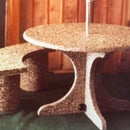Introduction: Easy Zero Clearance Throatplate for Any Table Saw
Tablesaws come with throat plate blade slots that are too wide for safe cuts on narrow boards.
Many aluminum saws and Sears saws come with thin throat plates that are difficult to duplicate with a zero clearance slot.
By epoxying a piece of masonite under your throat plate, and adding a filler strip, you can rip thin pieces much more safely.
Cut offs don't fall into the slot and kickback at you; and you have a perfect mark of where the blade cuts - in front of the blade.
You can also add a splitter pin (ten cents) after the blade in a couple of seconds. Check out the splitter in step 4. It even works with thick plates.
After ripping a few million linear feat of lumber at the wood shows demonstrating the Grip-Tite, I have become a firm believer in zero clearance plates, as well as not putting my fingers close to a saw blade.
Jerry Jaksha
This is a redo of an earlier instructable that I somehow unknowingly removed.
I put in a link to a 1 minute video that shows cutting thin strips on a tablesaw with this zero clearance plate.
Warning! It is advertising a hold down/ feeder. I don't cut thin strips using my fingers and a push stick. Any hold down is better than your fingers. If you clamp hold downs before and after the blade your rip cuts are much much much safer.
Safe table saw cuts using $29.95 feeder www.grip-tite.com - YouTube
Step 1: Epoxy Support Masonite Under Plate.
First clean the bottom of the plate with solvents like acetone and lacquer thinner, then sand.
Use epoxy to glue a piece of masonite or plywood under the plate. Be sure to keep it away from the edge support areas.
Wood glue will not work.
Super glue will not work- too brittle.
On a cheap jobsite saw, you may have to do a some modification, but you can make it work even when nothing supports the wood on one side. Make the support plate span the same area as the open space on those.
Step 2: Add Filler Strip
Cut a filler strip the same thickness as the plate, and glue in place.
You might want to use a glue that you can soften with heat, so you can remove and replace it after it gets old.
I used wood glue.
Cutting the filler thicker lets you sand it perfectly with the plate.
Many woodworkers don't realize how important it is to have a very flat plate, level with the saw. Lots of kickbacks happen when the board shifts as it is cut because the wood is not supported well, especially smaller pieces
Step 3: Cut the Slot
Put the plate in upside down, and clamp it down with bar clamps and a board or a wood subfence.
Raise the blade slowly an inch or so. Then you can flip it over and complete the cut, also clamping down.
Always cut the slot as high as the blade will go so you do not accidently cut into the plate when raising the blade.
Step 4: Splitter
Now you can add a splitter pin into the wood area after the blade.
Rip partly through a board, stop the cut, and drill into the kerf after the blade. (Make sure the blade cannot be raised into the splitter hole.)
Now you can insert a drill bit, a finish nail with head removed, or go high tech and use a hook with threads like the one shown.
The hook threads keep it down and lets you remove with your fingers.
A simple pin after the blade keeps the wood aligned with the blade, and is better stopping kickback than a long flat splitter, because the wood can pinch after the splitter and hold itself against kickback.
Wood Magazine tested an identical but adjustable splitter ( Splitter ) and said it works just as well as the $120.00 ones from Delta and Excalibur

Participated in the
Woodworking Challenge













